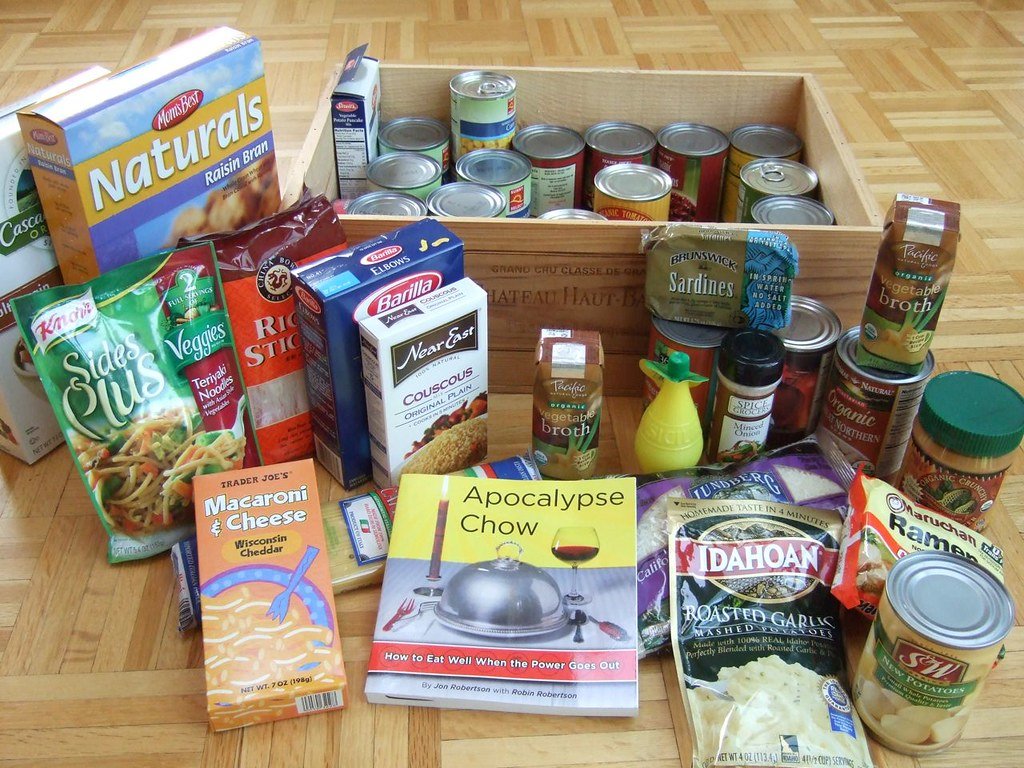Now Reading: How to Create a Rotating Food Storage System
-
01
How to Create a Rotating Food Storage System

How to Create a Rotating Food Storage System
Have you ever found yourself staring into a disheveled pantry, overwhelmed by the clutter and expiration dates of long-forgotten canned goods? As our lives become increasingly fast-paced, it’s easy for our food storage to fall into disarray. But fear not, fellow pantry enthusiasts, for we have a solution that combines organization and efficiency in one whirlwind of culinary brilliance. Welcome to the world of rotating food storage systems—an innovative way to ensure that your pantry is always stocked with fresh, replenished supplies, and no tomato sauce goes unnoticed. Join us today as we navigate the art of creating a rotating food storage system, where chaos and clutter are banished, and culinary harmony reigns supreme.
Table of Contents
- Planning Your Rotating Food Storage System
- Essential Components for a Successful Rotation System
- Organizing and Categorizing Your Food Stockpile
- Creating a Rotation Schedule and Tracking System
- Smart Strategies for Maintaining and Restocking Your Storage
- Q&A
- Final Thoughts

Planning Your Rotating Food Storage System
Creating a well-organized and efficient rotating food storage system can bring many benefits to your home. Whether you are preparing for emergencies or simply aiming to minimize food waste, a thoughtful plan can save you time, money, and ensure the freshness of your supplies. Here are some tips and considerations to help you design a practical and sustainable rotating food storage system:
- Assess your storage space: Before diving into the planning phase, take stock of the available space you have. Consider utilizing pantry shelves, cabinets, dedicated storage rooms, or even investing in space-saving racks or containers.
- Inventory and categorize: Begin by making an inventory of the food items you typically store and their shelf life. Categorize them into groups such as canned goods, dry goods, perishables, and long-term storage items. This step will help you allocate suitable storage spaces and prioritize rotation.
- Establish a FIFO system: FIFO, which stands for ”first in, first out,” is a principle widely used in stock management. Apply this concept to your food storage system by placing the newest items at the back and older ones at the front. Designate clear labels or use marker pens to indicate the purchase dates on the packaging.
- Consider repackaging: To extend the shelf life of bulk items or food in easily damaged packaging, consider repackaging them into airtight containers or vacuum-sealed bags. This step helps prevent spoilage, maintain freshness, and save space.
- Monitor and rotate: Regularly check your food storage system for expired or soon-to-expire items, and incorporate them into your meal plans before they go bad. Make a habit of rotating your supplies by moving older items to the front and placing new purchases to the back.
By investing some time and effort into , you can enjoy a well-managed pantry and ensure your supplies are always fresh and within their expiration dates. Plus, it adds a certain level of peace of mind knowing you are prepared for unexpected situations and reducing food waste along the way.

Essential Components for a Successful Rotation System
Implementing a efficient and well-structured rotation system is crucial for any organization looking to optimize productivity and teamwork. By ensuring an equal distribution of tasks and responsibilities among team members, a rotation system promotes skill development and strengthens employee engagement. Here are some essential components to consider when establishing a successful rotation system:
- Clear guidelines: Define the goals, expectations, and duration of each rotation period in order to provide employees with a clear understanding of their roles and responsibilities.
- Training and support: Offer appropriate training and support to ensure that employees have the necessary knowledge and skills to succeed during their rotation. This may include mentorship programs or specialized workshops.
- Transparent communication: Foster open communication channels, allowing team members to provide feedback, share ideas, and express concerns throughout the rotation process. This creates a collaborative environment and helps identify areas for improvement.
- Recognition and rewards: Acknowledge the efforts of employees who actively participate in the rotation system by recognizing their achievements and providing suitable rewards. This reinforces a culture of continuous learning and motivates individuals to embrace new challenges.
- Monitoring and evaluation: Regularly assess the effectiveness of the rotation system by monitoring key performance indicators, soliciting feedback from team members, and addressing any issues or concerns that may arise.
By incorporating these essential components into your rotation system, you can foster a positive work environment that encourages collaboration, professional growth, and overall success.
Organizing and Categorizing Your Food Stockpile
When it comes to stocking up on food for emergencies or simply being prepared for unpredictable times, having a well-organized and properly categorized food stockpile is essential. Not only does it make it easier to keep track of what you have, but it also ensures that you can easily locate the items you need when the time comes. Here are a few tips to help you get your food stockpile in order:
- Categorize by Food Group: To ensure a balanced and varied diet, categorize your food stockpile by food groups. This will allow you to easily identify and access different types of food when needed. Create sections for grains, protein sources (such as canned meat or beans), fruits and vegetables (dehydrated or canned), dairy products (powdered milk, cheese), and sweets or treats for morale-boosting.
- Label and Rotate: Label all your food items with their expiration dates and organize them in a way that allows for easy rotation. When adding new items to your stockpile, make sure to place them at the back so that older items are used first. This helps maintain freshness and ensures that nothing goes to waste.
- Consider Storage Conditions: Be mindful of the storage conditions required for different food items. For example, certain foods may need cooler temperatures or a dark environment to stay fresh longer. Take note of these requirements and store your stockpile accordingly.
Remember, an organized food stockpile not only helps during emergencies but also makes everyday meal planning easier. By categorizing, labeling, and considering storage conditions, you can ensure that your food stockpile remains in good condition, ready to sustain you and your loved ones whenever the need arises.
Creating a Rotation Schedule and Tracking System
Managing a rotating schedule can be a daunting task, but with the right system in place, it becomes a breeze. A rotation schedule ensures fairness and equal distribution of responsibilities among team members while also streamlining operations. To create an effective rotation schedule and tracking system, consider the following:
- Define Roles and Responsibilities: Start by clearly outlining the roles and responsibilities of each team member. This will help you determine the duration and frequency of rotations.
- Establish a Schedule: Create a calendar that specifies the rotation periods, ensuring that everyone has a chance to take on different tasks. Consider factors like workload, skillsets, and availability when creating the schedule.
- Implement a Tracking System: Utilize a tracking system to monitor the rotation schedule’s progress and to keep everyone informed. This could be a shared document or an online platform where employees can log their completed rotations and review upcoming ones.
By , you will empower your team and promote a fair and balanced work environment, leading to increased productivity and job satisfaction.
Smart Strategies for Maintaining and Restocking Your Storage
When it comes to managing your storage space effectively, it’s crucial to have smart strategies in place for both maintenance and restocking. Here are some tips to help you keep your storage organized and stocked:
- Regularly declutter: To maintain an efficient storage area, it’s essential to regularly declutter and get rid of items you no longer need. This will free up valuable space and prevent clutter from building up over time.
- Create a labeling system: A well-organized storage is easier to manage, and having a clear labeling system can make finding items a breeze. Utilize labels on shelves, boxes, or containers to quickly identify and locate what you need when restocking.
- Establish inventory management: Keeping track of your inventory is key to efficient restocking. Whether it’s through a digital tracking system or manual recording, maintaining an inventory list will help you monitor stock levels, avoid shortages, and plan for future restocking needs.
- Implement a first-in, first-out policy: To prevent items from expiring or becoming obsolete, adopt a first-in, first-out (FIFO) approach. Place new stock at the back of the storage area, ensuring that older items are used or sold first.
- Consider storage organization aids: Invest in storage aids such as shelving units, storage bins, or dividers to maximize space and maintain organization. These tools can make it easier to categorize and access items, ensuring a tidy and efficient storage environment.
- Regularly review and restock: Set aside time to review your inventory and assess restocking needs periodically. This proactive approach will help you stay on top of inventory levels, prevent stockouts, and ensure your storage remains well-stocked and ready to meet your needs.
By following these smart strategies, you can maintain an organized and efficient storage space while effectively restocking your inventory whenever necessary.
Q&A
How can I create a rotating food storage system?
Creating a rotating food storage system involves organizing your pantry in a way that ensures older items are used before newer ones. Arrange food items by expiration date and regularly rotate them so nothing goes to waste.
What are the benefits of a rotating food storage system?
A rotating food storage system helps to minimize food waste by ensuring that older items are used first. It also allows you to have a better overview of your inventory, making it easier to plan meals and shop for groceries.
What types of containers are best for a rotating food storage system?
Transparent, airtight containers are ideal for a rotating food storage system as they keep food fresh for longer and allow you to easily see what’s inside. Opt for stackable containers to save space and ensure efficient rotation.
How should I organize my pantry for a rotating food storage system?
Divide your pantry into different sections based on food categories, such as grains, canned goods, snacks, etc. Within each section, arrange items by expiration date, with the ones expiring soonest placed in the front for easy access.
How often should I rotate my food storage system?
It is recommended to rotate your food storage system every 3-6 months, depending on the shelf life of the items you store. Regularly check expiration dates, and when necessary, use the oldest items first and replace them with newer ones.
What are some tips for maintaining a rotating food storage system?
Make sure to label containers with expiration dates, and regularly check and update them to keep your system organized. Take note of items that are close to expiration and incorporate them into your meal planning to avoid wastage.
Can a rotating food storage system work for perishable items?
While a rotating food storage system is most effective for non-perishable items, you can still apply the concept to perishable items like refrigerated or frozen foods. Place older items towards the front and consume them first to prevent spoilage.
Final Thoughts
As we conclude this journey towards building your very own rotating food storage system, it’s fascinating to think about the endless possibilities that lie ahead. By implementing this ingenious and efficient method, you’ve taken a giant leap towards ensuring food security for you and your loved ones.
Today, we delved into the fundamentals of creating a rotating food storage system – from selecting the ideal storage space to organizing your supplies in a way that maximizes freshness and minimizes waste. We explored the significance of proper inventory management, allowing you to stay well-stocked and prepared for any situation life may throw your way.
Remember, a rotating food storage system is not just about hoarding canned goods and emergency rations; it’s about fostering a sense of self-sufficiency and peace of mind. With your newfound knowledge, you possess the power to withstand disruption or uncertainty, transforming your pantry into a fortress of serenity.
Upon embarking on this endeavor, you’ve embraced a path towards resilience and adaptability. Whether you’re confronted with extreme weather events, economic upheaval, or simply need a quick meal on a busy day, your rotating food storage system will be there, faithfully rotating through your supplies and offering sustenance when you need it most.
As we bid farewell, we urge you to share this valuable information with friends and family members. By spreading the knowledge of rotating food storage systems, you contribute to a resilient and prepared society. Together, we can empower each other, fostering a community that stands strong against unexpected challenges.
So, go forth and embark on this exciting journey of creating your own rotating food storage system. Arm yourself with the tools necessary to conquer uncertainty, all while exploring new recipe ideas and discovering the joy of culinary creativity. Bon appétit and may your pantry forever be stocked and your meals always delightful!
As an affiliate, my content may feature links to products I personally use and recommend. By taking action, like subscribing or making a purchase, you’ll be supporting my work and fueling my taco cravings at the same time. Win-win, right?
Want to read more? Check out our Affiliate Disclosure page.




